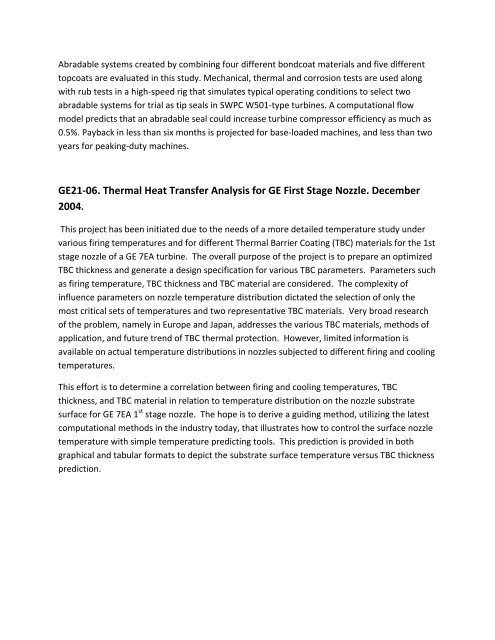GE94-02: Repair Flow Testing and Calibration Procedures for ...
GE94-02: Repair Flow Testing and Calibration Procedures for ...
GE94-02: Repair Flow Testing and Calibration Procedures for ...
You also want an ePaper? Increase the reach of your titles
YUMPU automatically turns print PDFs into web optimized ePapers that Google loves.
Abradable systems created by combining four different bondcoat materials <strong>and</strong> five different<br />
topcoats are evaluated in this study. Mechanical, thermal <strong>and</strong> corrosion tests are used along<br />
with rub tests in a high‐speed rig that simulates typical operating conditions to select two<br />
abradable systems <strong>for</strong> trial as tip seals in SWPC W501‐type turbines. A computational flow<br />
model predicts that an abradable seal could increase turbine compressor efficiency as much as<br />
0.5%. Payback in less than six months is projected <strong>for</strong> base‐loaded machines, <strong>and</strong> less than two<br />
years <strong>for</strong> peaking‐duty machines.<br />
GE21‐06. Thermal Heat Transfer Analysis <strong>for</strong> GE First Stage Nozzle. December<br />
2004.<br />
This project has been initiated due to the needs of a more detailed temperature study under<br />
various firing temperatures <strong>and</strong> <strong>for</strong> different Thermal Barrier Coating (TBC) materials <strong>for</strong> the 1st<br />
stage nozzle of a GE 7EA turbine. The overall purpose of the project is to prepare an optimized<br />
TBC thickness <strong>and</strong> generate a design specification <strong>for</strong> various TBC parameters. Parameters such<br />
as firing temperature, TBC thickness <strong>and</strong> TBC material are considered. The complexity of<br />
influence parameters on nozzle temperature distribution dictated the selection of only the<br />
most critical sets of temperatures <strong>and</strong> two representative TBC materials. Very broad research<br />
of the problem, namely in Europe <strong>and</strong> Japan, addresses the various TBC materials, methods of<br />
application, <strong>and</strong> future trend of TBC thermal protection. However, limited in<strong>for</strong>mation is<br />
available on actual temperature distributions in nozzles subjected to different firing <strong>and</strong> cooling<br />
temperatures.<br />
This ef<strong>for</strong>t is to determine a correlation between firing <strong>and</strong> cooling temperatures, TBC<br />
thickness, <strong>and</strong> TBC material in relation to temperature distribution on the nozzle substrate<br />
surface <strong>for</strong> GE 7EA 1 st stage nozzle. The hope is to derive a guiding method, utilizing the latest<br />
computational methods in the industry today, that illustrates how to control the surface nozzle<br />
temperature with simple temperature predicting tools. This prediction is provided in both<br />
graphical <strong>and</strong> tabular <strong>for</strong>mats to depict the substrate surface temperature versus TBC thickness<br />
prediction.


